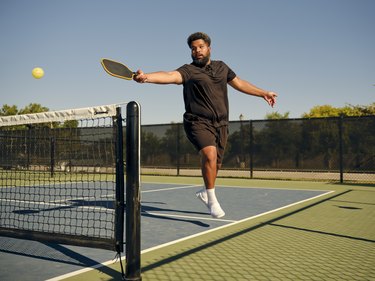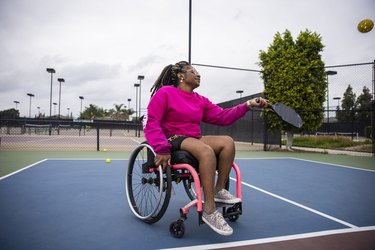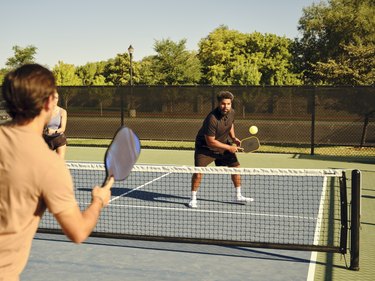
One reason for pickleball's exploding popularity? You don't have to be super fit to join the fun. But if you want to up your game and enjoy your time on the court even more, a little off-court training can help.
"To enjoy pickleball, you just need to be able to move your body," Darci Revier, CSCS, director of education for the National Exercise Trainers Association and author of Conditioning for Pickleball, tells LIVESTRONG.com. "That's why we see older adults able to participate. We see kids able to participate. In general, as long as you have a baseline level of fitness and aren't coming from a completely sedentary lifestyle, it's completely possible for you to participate."
Video of the Day
Pickleball is fun for people who have had some time off from exercise, too, Ernie Medina, a USA Pickleball ambassador and coach, says: "It's scalable to whatever fitness level you're at."
Pickleball's scalability and accessibility are among the reasons it has been the fastest-growing sport in the United States for three years in a row, according to the Sports & Fitness Industry Association. The group's annual report showed that participation in pickleball doubled last year, and has grown 158.6 percent over the past three.
Here are the skills and types of fitness experts say you'll need to play your best, and five pickleball exercises you can do anywhere to improve your game — in just 15-minutes.
Getting Fit for Pickleball
Pickleball can be played by anyone, but that doesn't mean it's risk-free. Based on hospital visits in 2017 — before the pickleball boom of the past few years — the Journal of Emergency Medicine estimated that there were 19,012 pickleball injuries in the U.S. per year requiring an emergency room visit. So getting fit in new ways can not just make you a better player, but may help prepare your body for the slips, trips and falls you'll encounter as the game speeds up.
Here are five key pickleball fitness skills and how you can improve each.
Lowering Your Center of Gravity
Not every pickleball shot will be over your head or at waist height: To win points, you'll also need to reach down and hit balls near the ground. For new players, especially those carrying some extra weight, Medina says, getting low can be a challenge.
"For these players, bending their knees can be really tough," he says. "So they'll bend over at the waist, and then their balance is off."
Lost balance can mean missed shots, as well as dangerous falls. Being able to lower your center of gravity while keeping your balance is key. To improve at bending in this way, Medina suggests players perform squatting and lunging movements, even with external support for balance.
One move he likes for beginning squatters is a "kitchen squat." To do it, stand in front of a kitchen counter with your feet shoulder- to hip-width apart. Hold the counter for balance, and push your hips back to squat, bending your knees and lowering your body while keeping your torso upright. Keep the weight of your body in your heels as you go down and press back up.
Holding the counter will give you the confidence, Medina says, to practice lowering your center of gravity without toppling over.
Moving Side to Side and Diagonally
Most of our lives are spent moving forward and backward: when we're walking, getting in and out of chairs and even when doing exercises like running, squatting, bench pressing or lunging. But pickleball requires players to move in all directions, Revier says.
Players might step forward diagonally to make one shot, shuffle to the side to make another or step backward diagonally to lean back and try to save a ball that's almost past them, she says. All of these motions challenge your balance and your muscles in directions they may not be used to moving, which can diminish performance (and also lead to sprains and strains).
To train for these types of movements, Revier suggests short agility drills that have players shuffling to the sides and moving diagonally, as well as lunges in multiple directions. One of her favorites is a clock lunge: The move starts out like a normal lunge, stepping straight in front. But then it requires the exerciser to step out at a 30- or 45-degree angle, to the side at a 90-degree angle, backwards while pivoting, and then straight back.
Back Pedaling
Running backward to get to a ball is one of the most common ways pickleball players get injured, Medina says. Many players are not used to running backward, so they trip and fall, either bonking their heads or reaching out with their hands, injuring their wrists.
Since the court is long, you don't need to backpedal far to practice, Revier says. From the baseline of a court, hold a paddle and practice running in a short burst toward the net, then backpedaling to the start. Doing this in short bursts with equal breaks will also help players build the quickness and start-and-stop endurance that pickleball requires. Try doing these charge-and-retreat runs for 15 seconds on, then rest for 15 seconds before repeating.
Endurance to Start, Stop and Start Again
Pickleball requires endurance, but not the same type you need to run a 5K, Revier says. Instead, the sport requires players to be able to exert themselves and recover quickly.
That's a lot like high-intensity interval training (HIIT), she says, where trainees alternate short bouts of intense effort with bits of rest. So HIIT is a great way to train for pickleball success! The workout below is designed in a HIIT format, so you'll improve pickleball-specific fitness skills and build this type of endurance.
Grip Strength
New players aren't used to gripping a paddle and ripping shots, Revier says. A strong grip can help players control the paddle and make more shots. And it could help you build the type of fitness that keeps you playing for a long time: Research, like this November 2022 study from the Journal of Cachexia, Sarcopenia and Muscle, associates having a strong grip with overall health and longevity.
While players can strengthen their grips with hand grippers or by squeezing a tennis ball or stress ball, Revier says that strength in the other direction — opening the fingers — is also key.
This can be practiced by putting a strong rubber resistance band around the hand, or even by resisting using your other hand: Make a fist with your right hand, and wrap your left hand around the fingers of the fist. Now try to open your fist while resisting the opening using your left hand. Do this for holds of 5 seconds each to start. Try this exercise for a few minutes before or after the 15-minute workout below.
5 Pickleball Exercises You Can Do Anywhere
This short workout will help players build strength in their lower bodies while practicing lowering their center of gravity and moving in different planes. It helps players build rotational core strength, which is needed on many swings of the paddle. And it requires almost no equipment: If you don't have access to a stability ball for the wall ball squat, replace it with the "kitchen squat" described above.
It's designed in a high-intensity interval training, or HIIT, format. Perform each exercise for 30 seconds, then rest for 30 seconds. Repeat this for each move two more times — 30 seconds on, 30 seconds off. Then move to the next exercise. That's three minutes per exercise, so the whole workout should take 15 minutes.
If you want to make the workout more advanced, you can add weight: Hold dumbbells or medicine balls in your hands during the squat, lunge and core rotation. You can also make it tougher by increasing the amount of time you're working, and reducing the amount of time you're resting. So after you get used to the moves, try working for 32 seconds, and resting for 28. Then work for 35, and rest for 25.
Perform each exercise for three rounds of 30 seconds each, resting 30 seconds between rounds.
1. Stability Ball Wall Squat
- Place a stability ball against a wall and lean your back against it. The top of the ball should be in contact with your mid-back, low back and tailbone.
- Position your feet so they’re hip-width apart and 6 to 12 inches farther from the wall than your body is.
- Keep the weight in your heels, push your hips back and bend your knees to squat. As you descend, the ball will roll down the wall with you. Descend until your knees are bent around 90 degrees.
- Press through your heels to stand back to the starting position. The ball will roll back up the wall with you.
2. Clock Lunge
- Stand with your feet shoulder-width apart. Imagine your feet are both facing 12 o’clock.
- Take a large lunge step forward with your right leg, descending as you step until your knees both form 90-degree angles.
- Press through your right foot to stand back up.
- Now lunge again with your right foot, but step your right foot toward 2 o’clock. Stand back up.
- Now lunge toward 3 o’clock. Take a big step to the right, pushing your hips back and descending as you step by bending your right knee, keeping it tracking over your right toes. Keep your torso upright as you descend, the position of your arms not changing in relation to your body.
- Stand back up, and lunge toward 5 o’clock.
- Now lunge straight backward, toward 6 o’clock.
- Now do the same thing with your left leg: Lunge toward 12, then 10, then 9, 7 and finally 6.
Finding balance to be tough on the clock lunges? Stand near a pole or fence post so you can hold on to it as needed.
3. Sprint Up, Pedal Back
- Mark about 15 feet of running space.
- Run up the 15 feet.
- As quickly as possible, change direction and backpedal to the start.
- Repeat for 30 seconds.
4. 4-Cone Box Drill
- Set up four cones in a large square, with each cone 5 to 10 feet from each other. Start at the bottom right cone of your square.
- Run forward to the upper right cone.
- Shuffle left to the upper left cone.
- Backpedal to the lower left cone.
- Shuffle right back to the start.
- Repeat for 30 seconds: Run forward, shuffle left, backpedal and shuffle right.
5. Tight Core Rotation
- Stand with your feet hip-width apart. Bend your knees to get into an athletic stance, and hold your arms in front of your chest, palms together. Imagine your hands are pointing toward 12 on a clock.
- Twisting from your mid-back, not your low back, turn your shoulders and hands so that your hands point to 10 o’clock.
- Then quickly switch back so your hands point to 2 o’clock.
- Keep rotating back and forth in this way for 30 seconds.


